Wan Liu
Neural Beamforming with Doppler-Aware Sparse Attention for High Mobility Environments
Nov 05, 2025Abstract:Beamforming has significance for enhancing spectral efficiency and mitigating interference in multi-antenna wireless systems, facilitating spatial multiplexing and diversity in dense and high mobility scenarios. Traditional beamforming techniques such as zero-forcing beamforming (ZFBF) and minimum mean square error (MMSE) beamforming experience performance deterioration under adverse channel conditions. Deep learning-based beamforming offers an alternative with nonlinear mappings from channel state information (CSI) to beamforming weights by improving robustness against dynamic channel environments. Transformer-based models are particularly effective due to their ability to model long-range dependencies across time and frequency. However, their quadratic attention complexity limits scalability in large OFDM grids. Recent studies address this issue through sparse attention mechanisms that reduce complexity while maintaining expressiveness, yet often employ patterns that disregard channel dynamics, as they are not specifically designed for wireless communication scenarios. In this work, we propose a Doppler-aware Sparse Neural Network Beamforming (Doppler-aware Sparse NNBF) model that incorporates a channel-adaptive sparse attention mechanism in a multi-user single-input multiple-output (MU-SIMO) setting. The proposed sparsity structure is configurable along 2D time-frequency axes based on channel dynamics and is theoretically proven to ensure full connectivity within p hops, where p is the number of attention heads. Simulation results under urban macro (UMa) channel conditions show that Doppler-aware Sparse NNBF significantly outperforms both a fixed-pattern baseline, referred to as Standard Sparse NNBF, and conventional beamforming techniques ZFBF and MMSE beamforming in high mobility scenarios, while maintaining structured sparsity with a controlled number of attended keys per query.
Transformer-Driven Neural Beamforming with Imperfect CSI in Urban Macro Wireless Channels
Apr 15, 2025

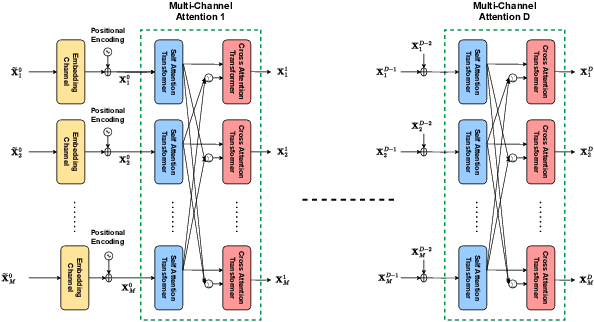

Abstract:The literature is abundant with methodologies focusing on using transformer architectures due to their prominence in wireless signal processing and their capability to capture long-range dependencies via attention mechanisms. In particular, depthwise separable convolutions enhance parameter efficiency for the process of high-dimensional data characteristics of MIMO systems. In this work, we introduce a novel unsupervised deep learning framework that integrates depthwise separable convolutions and transformers to generate beamforming weights under imperfect channel state information (CSI) for a multi-user single-input multiple-output (MU-SIMO) system in dense urban environments. The primary goal is to enhance throughput by maximizing sum-rate while ensuring reliable communication. Spectral efficiency and block error rate (BLER) are considered as performance metrics. Experiments are carried out under various conditions to compare the performance of the proposed NNBF framework against baseline methods zero-forcing beamforming (ZFBF) and minimum mean square error (MMSE) beamforming. Experimental results demonstrate the superiority of the proposed framework over the baseline techniques.
How Critical is Site-Specific RAN Optimization? 5G Open-RAN Uplink Air Interface Performance Test and Optimization from Macro-Cell CIR Data
Oct 25, 2024



Abstract:In this paper, we consider the importance of channel measurement data from specific sites and its impact on air interface optimization and test. Currently, a range of statistical channel models including 3GPP 38.901 tapped delay line (TDL), clustered delay line (CDL), urban microcells (UMi) and urban macrocells (UMa) type channels are widely used for air interface performance testing and simulation. However, there remains a gap in the realism of these models for air interface testing and optimization when compared with real world measurement based channels. To address this gap, we compare the performance impacts of training neural receivers with 1) statistical 3GPP TDL models, and 2) measured macro-cell channel impulse response (CIR) data. We leverage our OmniPHY-5G neural receiver for NR PUSCH uplink simulation, with a training procedure that uses statistical TDL channel models for pre-training, and fine-tuning based on measured site specific MIMO CIR data. The proposed fine-tuning method achieves a 10% block error rate (BLER) at a 1.85 dB lower signal-to-noise ratio (SNR) compared to pre-training only on simulated TDL channels, illustrating a rough magnitude of the gap that can be closed by site-specific training, and gives the first answer to the question "how much can fine-tuning the RAN for site-specific channels help?"
The shape of the brain's connections is predictive of cognitive performance: an explainable machine learning study
Oct 19, 2024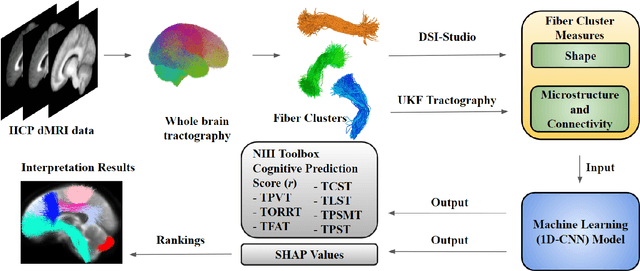
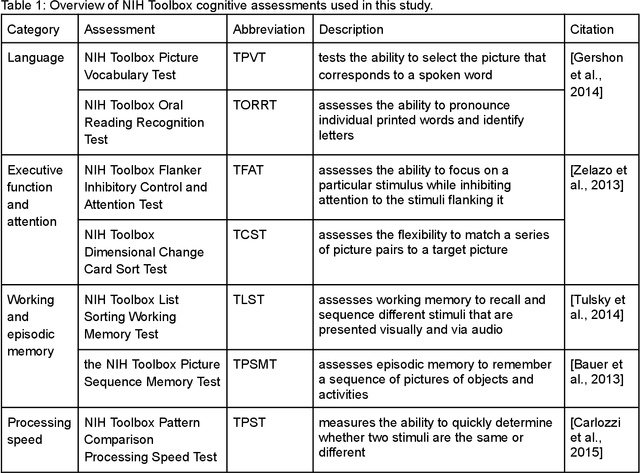

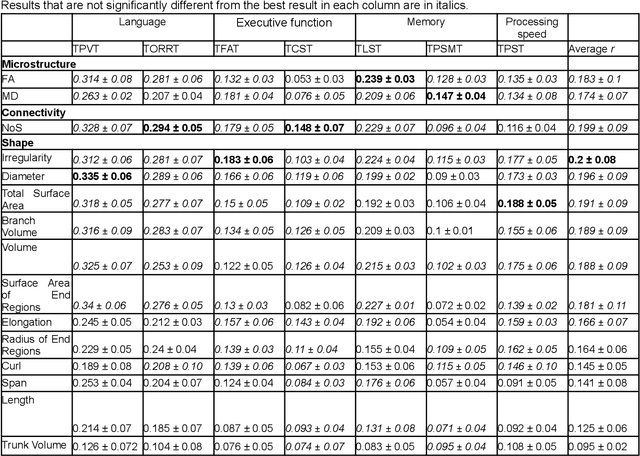
Abstract:The shape of the brain's white matter connections is relatively unexplored in diffusion MRI tractography analysis. While it is known that tract shape varies in populations and across the human lifespan, it is unknown if the variability in dMRI tractography-derived shape may relate to the brain's functional variability across individuals. This work explores the potential of leveraging tractography fiber cluster shape measures to predict subject-specific cognitive performance. We implement machine learning models to predict individual cognitive performance scores. We study a large-scale database from the HCP-YA study. We apply an atlas-based fiber cluster parcellation to the dMRI tractography of each individual. We compute 15 shape, microstructure, and connectivity features for each fiber cluster. Using these features as input, we train a total of 210 models to predict 7 different NIH Toolbox cognitive performance assessments. We apply an explainable AI technique, SHAP, to assess the importance of each fiber cluster for prediction. Our results demonstrate that shape measures are predictive of individual cognitive performance. The studied shape measures, such as irregularity, diameter, total surface area, volume, and branch volume, are as effective for prediction as microstructure and connectivity measures. The overall best-performing feature is a shape feature, irregularity, which describes how different a cluster's shape is from an idealized cylinder. Further interpretation using SHAP values suggest that fiber clusters with features highly predictive of cognitive ability are widespread throughout the brain, including fiber clusters from the superficial association, deep association, cerebellar, striatal, and projection pathways. This study demonstrates the strong potential of shape descriptors to enhance the study of the brain's white matter and its relationship to cognitive function.
Cross-domain Fiber Cluster Shape Analysis for Language Performance Cognitive Score Prediction
Mar 30, 2024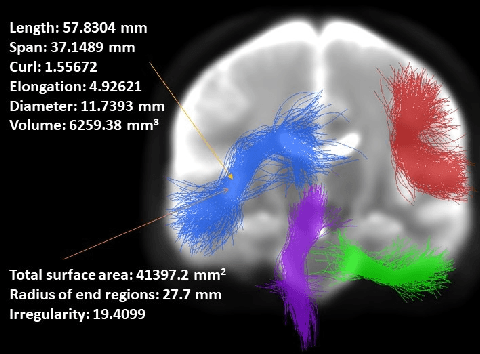
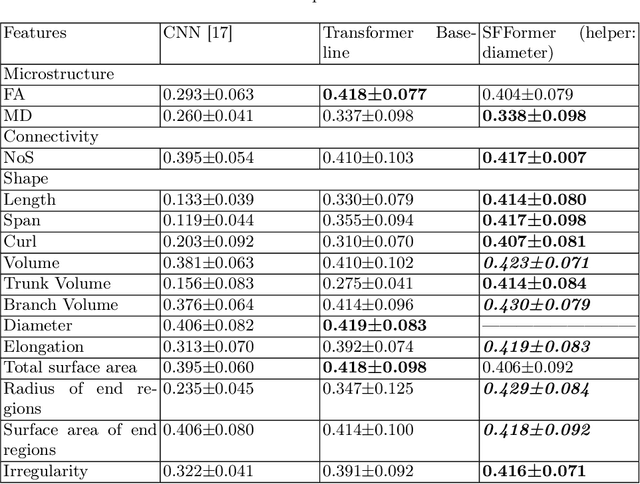
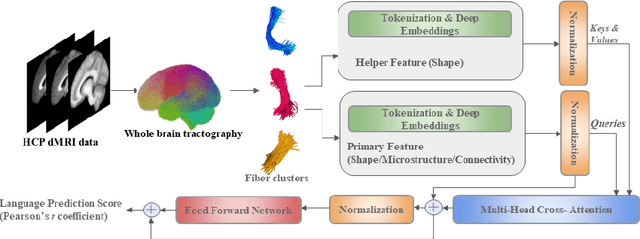
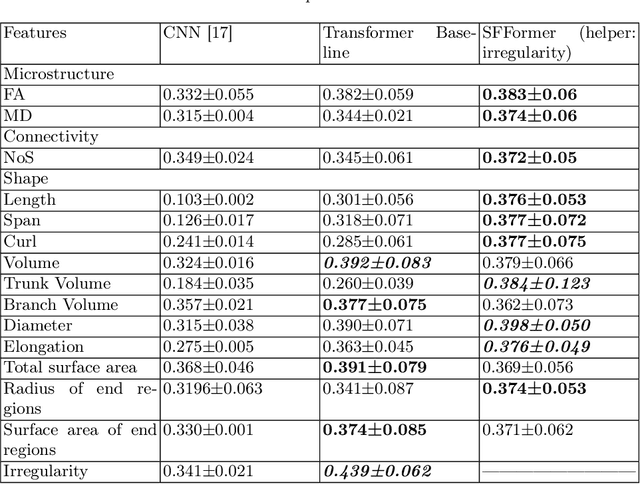
Abstract:Shape plays an important role in computer graphics, offering informative features to convey an object's morphology and functionality. Shape analysis in brain imaging can help interpret structural and functionality correlations of the human brain. In this work, we investigate the shape of the brain's 3D white matter connections and its potential predictive relationship to human cognitive function. We reconstruct brain connections as sequences of 3D points using diffusion magnetic resonance imaging (dMRI) tractography. To describe each connection, we extract 12 shape descriptors in addition to traditional dMRI connectivity and tissue microstructure features. We introduce a novel framework, Shape--fused Fiber Cluster Transformer (SFFormer), that leverages a multi-head cross-attention feature fusion module to predict subject-specific language performance based on dMRI tractography. We assess the performance of the method on a large dataset including 1065 healthy young adults. The results demonstrate that both the transformer-based SFFormer model and its inter/intra feature fusion with shape, microstructure, and connectivity are informative, and together, they improve the prediction of subject-specific language performance scores. Overall, our results indicate that the shape of the brain's connections is predictive of human language function.
Better Generalization of White Matter Tract Segmentation to Arbitrary Datasets with Scaled Residual Bootstrap
Sep 25, 2023Abstract:White matter (WM) tract segmentation is a crucial step for brain connectivity studies. It is performed on diffusion magnetic resonance imaging (dMRI), and deep neural networks (DNNs) have achieved promising segmentation accuracy. Existing DNN-based methods use an annotated dataset for model training. However, the performance of the trained model on a different test dataset may not be optimal due to distribution shift, and it is desirable to design WM tract segmentation approaches that allow better generalization of the segmentation model to arbitrary test datasets. In this work, we propose a WM tract segmentation approach that improves the generalization with scaled residual bootstrap. The difference between dMRI scans in training and test datasets is most noticeably caused by the different numbers of diffusion gradients and noise levels. Since both of them lead to different signal-to-noise ratios (SNRs) between the training and test data, we propose to augment the training scans by adjusting the noise magnitude and develop an adapted residual bootstrap strategy for the augmentation. To validate the proposed approach, two dMRI datasets were used, and the experimental results show that our method consistently improved the generalization of WM tract segmentation under various settings.
Fiber Tract Shape Measures Inform Prediction of Non-Imaging Phenotypes
Mar 16, 2023



Abstract:Neuroimaging measures of the brain's white matter connections can enable the prediction of non-imaging phenotypes, such as demographic and cognitive measures. Existing works have investigated traditional microstructure and connectivity measures from diffusion MRI tractography, without considering the shape of the connections reconstructed by tractography. In this paper, we investigate the potential of fiber tract shape features for predicting non-imaging phenotypes, both individually and in combination with traditional features. We focus on three basic shape features: length, diameter, and elongation. Two different prediction methods are used, including a traditional regression method and a deep-learning-based prediction method. Experiments use an efficient two-stage fusion strategy for prediction using microstructure, connectivity, and shape measures. To reduce predictive bias due to brain size, normalized shape features are also investigated. Experimental results on the Human Connectome Project (HCP) young adult dataset (n=1065) demonstrate that individual shape features are predictive of non-imaging phenotypes. When combined with microstructure and connectivity features, shape features significantly improve performance for predicting the cognitive score TPVT (NIH Toolbox picture vocabulary test). Overall, this study demonstrates that the shape of fiber tracts contains useful information for the description and study of the living human brain using machine learning.
One-Shot Segmentation of Novel White Matter Tracts via Extensive Data Augmentation
Mar 13, 2023Abstract:Deep learning based methods have achieved state-of-the-art performance for automated white matter (WM) tract segmentation. In these methods, the segmentation model needs to be trained with a large number of manually annotated scans, which can be accumulated throughout time. When novel WM tracts, i.e., tracts not included in the existing annotated WM tracts, are to be segmented, additional annotations of these novel WM tracts need to be collected. Since tract annotation is time-consuming and costly, it is desirable to make only a few annotations of novel WM tracts for training the segmentation model, and previous work has addressed this problem by transferring the knowledge learned for segmenting existing WM tracts to the segmentation of novel WM tracts. However, accurate segmentation of novel WM tracts can still be challenging in the one-shot setting, where only one scan is annotated for the novel WM tracts. In this work, we explore the problem of one-shot segmentation of novel WM tracts. Since in the one-shot setting the annotated training data is extremely scarce, based on the existing knowledge transfer framework, we propose to further perform extensive data augmentation for the single annotated scan, where synthetic annotated training data is produced. We have designed several different strategies that mask out regions in the single annotated scan for data augmentation. Our method was evaluated on public and in-house datasets. The experimental results show that our method improves the accuracy of one-shot segmentation of novel WM tracts.
 Add to Chrome
Add to Chrome Add to Firefox
Add to Firefox Add to Edge
Add to Edge